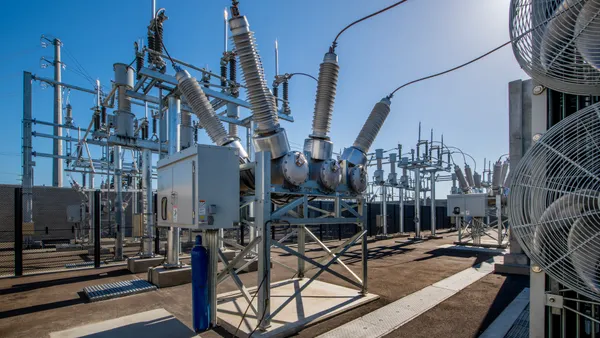Grid-outage recovery is only as fast and reliable as the communication technology supporting it. For many utilities, this is a growing infrastructure challenge especially as distributed energy resources (DER) increase on the grid.
Most utilities rely on traditional copper-wire telecommunication for direct transfer trip (DTT), to disconnect the distributed energy power source connected to a feeder as a safety measure when there is a grid problem or while repairs are made. Under proper operation, when a fault is detected, a substation sends a trip signal to the DTT to disconnect the distributed energy source.
But as these communication lines age, they are more prone to fail. When DTT communication goes down, a distributed energy site will switch off by default as a safety measure. This causes an outage for the distributed energy site, until the communication is restored — even if all power-related aspects of that feeder are operating properly.
Aside from inconveniencing the utility and distributed energy site owners, communication-related outages can have a significant business impact for the distributed-generation providers, such as solar farms. Every minute of lost grid connection is an effective curtailment that costs money. More frequent and longer interruptions can significantly impair the economics of distributed generation.
If a traditional DTT communication line needs repair, it might take hours or days, depending on the length of the line and the remoteness of the location. Rerouting signals is rarely an option with hard-wired connections. Also, replacing a traditional DTT line with new copper or fiber-optic cable tends to be prohibitively expensive — especially for smaller or rural utilities.
In recent years, more utilities have been voicing concerns about communication reliability as their DTT communication lines near the end of their useful life. This caught the attention of Siemens, which offers the Siemens Distribution Feeder Automation – Direct Transfer Trip solution (SDFA-DTT). Siemens’ DTT solution leverages cellular telecommunications to detect and isolate real grid faults in less than 500 milliseconds while completely avoiding false outages due to communication failures. Now, in pilot projects, Siemens has begun working with utilities to deploy cellular DTT communications as a stand-alone service.
Pilot Test at Virginia Ski Resort
The Central Virginia Electric Cooperative (CVEC) needed just such a solution. Last year, CVEC worked with Siemens to implement a cellular based Fault Location, Isolation and System Restoration (FLISR) system for three feeders at the Wintergreen Ski Resort. This project went live in January 2017.
Located in the Blue Ridge Mountains, the Wintergreen resort comprises about 2,000 utility accounts: ski lifts, restaurants, private homes, condos, and more. Just over half of these accounts are served by the feeders that were upgraded to cellular communications. By 2019, the remaining four feeders serving the resort will be similarly updated.

“This is very concentrated distribution infrastructure,” explained Joseph Key, Engineering Services Manager for CVEC. “A fault on one circuit could mean an outage affecting much of the resort. They have had a few outages that severely impacted commercial operations. During ski season, with thousands of people there, that can mean a substantial loss of revenue for the resort. We needed to minimize that impact.”
Wintergreen was constructed in the mid-1970s, with most utilities buried in the same ditch. “This makes cable repair very tedious,” Key said. “Lots of hand digging, sometimes in severe cold and snow, plus an hour’s drive to get a truck on site.”
In this rocky, mountainous terrain, radio and fiber-optic communications were neither feasible nor affordable. It was only in the last few years that telecom providers installed cell service throughout the resort. With that infrastructure in place, CVEC began planning with Siemens.
“Our main concerns were security, reliability and speed,” said Jeremy Watson, Automation and Control Engineer for CVEC. “We didn’t want any backdoor access channels into our network, for operating switchgear.”
Andre Smit, Feeder Automation Product Development Manager for Siemens, explained that Siemens’ DTT cellular solution incorporates security measures into both the software and the hardware. Furthermore, since encrypted protection signals successfully travel over the common cell network, there was no need to install a very costly private radio or fiber optic communication infrastructure — removing a prohibitive cost.
Benefits of Cellular Communications
Cellular communication is designed to instantly self-reroute, which means DTT signals are far less prone to a single-point failure. Signals often can reach their destination even if there’s a problem with one tower en route.
Switching to cellular communications provides other systemwide benefits. “We have better access and more visibility to intelligently monitor the communication on a feeder system,” Smit said. “This helps us see when problems might be developing, allowing us to adjust grid operations or communications before there’s a failure.”
The potential cost savings are substantial. Installing copper or fiber-optic cable can run into hundreds of thousands of dollars per line, especially at the grid edge. On top of that, phone companies can charge upward of $200 per month simply to keep that line open for rare but crucial trip signals, which occur perhaps one to five times per year. “But with a vastly less expensive and easier-to-install cell modem, we can control data intelligently, for about $5 per month.”
Through the Wintergreen resort pilot, CVEC learned that foliage can interfere with the cell signal. “We set the system up in winter; with no leaves, we had better access. But when the leaves came out, they began to block our signals,” Watson said. “Now we’re devising a new antenna scheme to kick the reliability back up. We can correct the original installation for this. Siemens was very helpful reacting to this problem and helping us find a solution quickly.”
Watson also noted that a cellular communications package offers the capacity to automate and sectionalize distribution. “This is a box that we can drop in place and plug it in to control numerous devices with one small Siemens solution,” he said. “For instance, we could instantly and automatically switch where one section of the grid draws power from. Once the switching is complete, a signal can be sent over cellular to reconfigure the settings groups in our relays ensuring that we are using the correct protection settings for the system configuration. To manually change the relays, it could take us an hour just to drive to the substation.”
Safe Solar Integration
CVEC is also working with Dominion Energy to apply Siemens’ cellular DTT technology to 10 megawatts of solar generation set to be connected to CVEC’s distribution grid later in 2017.
“Dominion requires a DTT scheme at our point of delivery to their transmission network,” Key said. “Their concern is, a fault on their transmission system will cause their breaker to trip, and if the solar generation on our side of the fault stays online, that could be dangerous and damaging to line personnel and equipment.”
In addition, this interconnection between Dominion and CVEC serves more than 7,000 customers, including major commercial facilities, one being a Walmart. “Dominion wouldn’t allow us to pick up that load until we proved that the solar farms are offline,” Key said. “So, on our side, we’ll set it up so that if Dominion trips off, we’ll trip off the solar farms for safety until the Dominion connection is restored.”
The situational awareness this system provides is expected to prove especially helpful for integrating large solar farms onto the utility grid. “With one of these modems at each solar farm, we’ll have visibility over the network and real-time data about system status,” Key said. “The modems at the solar farms will link up via cell to Dominion’s delivery point, but also to our SCADA system. We can monitor solar-farm output from our central dispatch center and adapt our distribution system to accommodate the solar power.”
Siemens plans to leverage the experience gained at CVEC and other pilot projects to enhance and expand this offering to other customers. “As grid communication infrastructure continues to age and distributed energy installation increases, utilities will more and more require solutions such as Siemens’ Distribution Feeder Automation-Direct Transfer Trip,” Smit said. “We are offering a revolutionizing solution that directly increases reliability at a very economical price. This isn’t just a matter of utility IT running service from field devices to a central system. These devices are communicating important information directly to each other. This is the future of flexible and scalable grid communications.”
To learn if your utility can benefit from Siemens’ cellular feeder automation solutions such as Direct Transfer Trip, visit our website.










